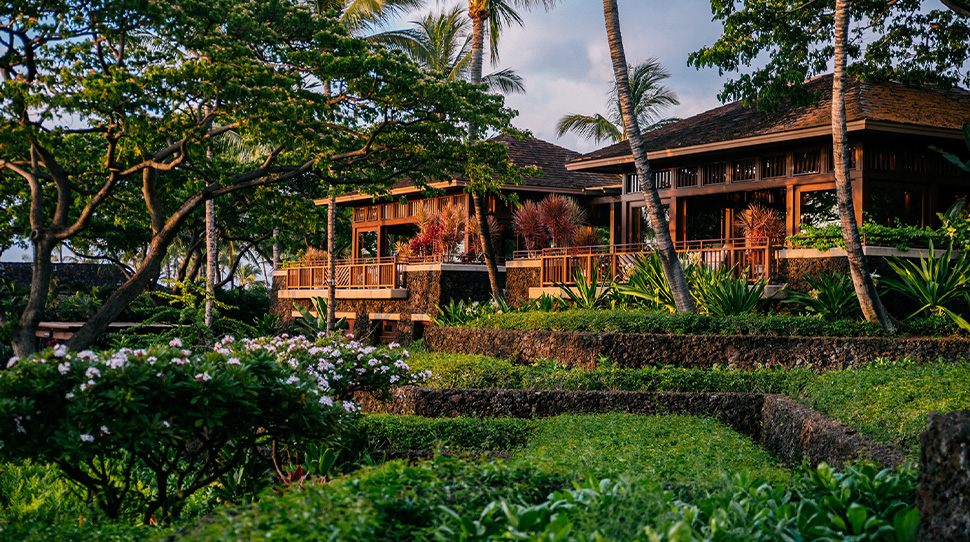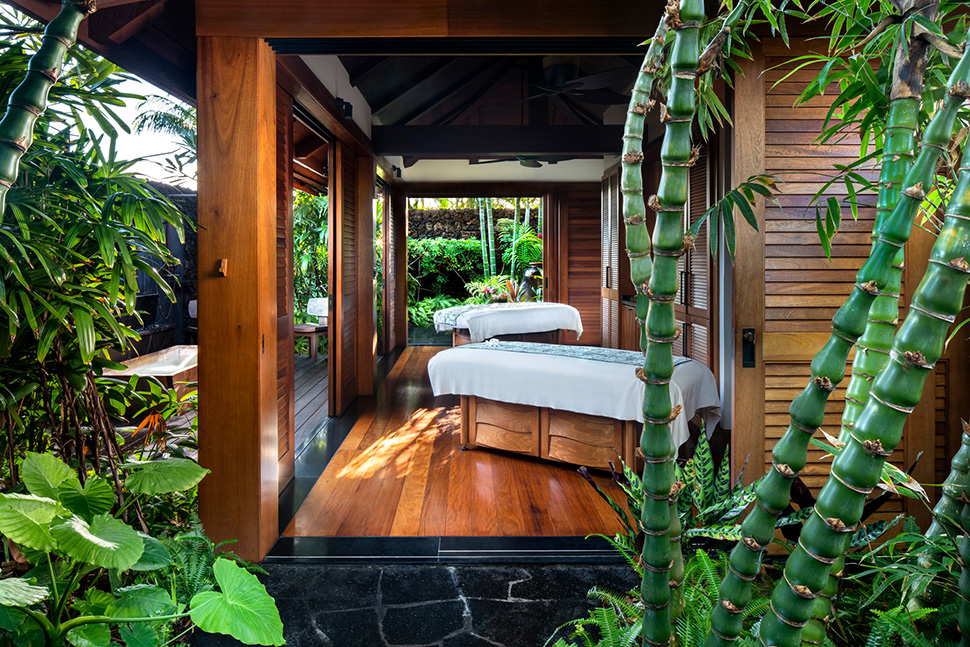

Tucked away on a secluded half-mile stretch along the Kona Coast on Hawaii’s Big Island, Four Seasons Resort Hualalai transports you to another world. Jagged black lava rocks creep from the shoreline into the expanse of never-ending water. Tropical greenery such as giant birds of paradise and palm-like traveler’s trees, whose leaves fan out in grand fashion, cover lush grounds, while kaffir limes, starfruit, papayas, bananas, ‘ulu (breadfruit), soursop and more dangle from branches.
But it isn’t just the unique landscape that’s transportive. Sprinkled among the verdant flora, low-slung wood bungalows send you back to Hawaii’s golden age with classic accommodations that draw loyal return guests year after year.
When the Forbes Travel Guide Five-Star hotel used time during the pandemic to close and undergo a large-scale $100 million renovation, the challenge for San Francisco-based firm BAMO (which designed Capella Bangkok and Chileno Bay Resort & Residences, Auberge Resorts Collection) was to modernize the beloved hideaway while maintaining its authentic Hawaiian feel.
From new villas to unique amenities, read on to see why you need to check into this refuge as it marks its 25th anniversary.

The New Villas
Four Seasons Resort Hualalai recently capped off its recent changes by debuting the state’s largest villas. The hotel took its most spacious single-story suites and converted them to villas, adding a second floor and lanais, and built another bungalow. Spanning 2,700 to 5,200 square feet, the three villas come with three to five bedrooms, private pools, Pelotons, wellness kits, a dedicated suite concierge and an elegant, natural décor that’s a tasteful evolution of the former accommodations. The still-classic spaces feature rich woods (including beautiful live-edge dining room tables and shuttered wood doors that open to a spacious, furnished lanai), slate floors, local artwork that pays homage to Hawaiian culture and an earthy palette of cream and beige. Each comes with outdoor black lava rock showers for an only-in-Kona experience.
While we could spend our days swimming at the Makaloa Villa’s curved pool overlooking Waiakauhi Pond (get a closer look at the 2.5-acre preserve and search for stilt, an endangered native Hawaiian bird, with the outdoor telescope) and swinging from the rope-hung daybed, the Hawaii Loa Presidential Villa stands out among the new offerings. The largest villa boasts a prime spot facing the Pacific Ocean with unobstructed views — you can even spot humpback whales in season — a spa on its lanai and a bedroom that runs the length of the villa.
According to general manager Charlie Parker, the villas have been in high demand, especially as multigenerational travel has been on the rise and larger spaces are needed.
Even if you don’t opt for one of the villas, all the property’s newly renovated rooms resemble the same look and feel. Measuring 635 square feet, the accommodations have earthy hues, organic materials, shuttered doors that can transform them into indoor-outdoor spaces and alfresco black lava rock showers.

The Revamped Pool
The Big Island hotel is built around four crescents, each of which wraps around an oceanfront pool and sets a specific mood. Families flock to the kid-friendly Sea Shell Pool, adults looking for a laid-back vibe make a beeline for the Palm Grove Pool and its in-water bar, and those seeking peace and quiet retreat to the cabana-lined Beach Tree Pool. But you shouldn’t miss visiting the unusual King’s Pond, a 1.8-million-gallon semi-saltwater swimming hole that’s more akin to an aquarium. Carved from lava rock, the pond holds nearly 1,000 fish. Borrow complimentary snorkel equipment and putter around to see 63 different fish species, including awa (milkfish), convict tang (named for its black stripes), porcupine pufferfish, butterfly fish and Hawaiian flagtail.
King’s Pond also saw upgrades during the renovation, including the addition of the Kumu Kai Marine Center. There a team of marine biologists leads complimentary activities like fish feedings, touch tank sessions and talks. The team launched new private activities, like a junior marine biologist experience, a tidepool tour and an eagle ray feeding, where you wade into the water and the rays glide up to you and slurp food from your hand. Among those feeding from your hands is likely to be Kainalu, a friendly spotted eagle ray who has been in the enviable position of living in the hotel for more than 20 years.
As part of the overhaul, King’s Pond debuted a new infinity-edge pool and two whirlpools perched above it. Dive into the new pool and on the bottom, you will find sculptures, one of Kainalu and another depicting a honu (sea turtle) by Kona artist Alex Gupton.

The Serene Spa
The hotel makes use of its idyllic setting for its Hualalai Spa. While ensconced in stunning tropical foliage as you wait for your treatment in the Waiea (“water of life”) Garden, you can sprawl out on a chaise lounge and watch the water fall from the oversized lava rocks. Or you can walk across the stone path along the shallow river for some reflexology and to soak up the serenity.
We could spend hours in this oasis, but then we would miss out on a service. The Four-Star spa offers 18 outdoor treatment rooms (BAMO gave the interiors a makeover in line with the rest of the resort’s aesthetic), and you can receive some services in your villa or specialty suite. Try lomi lomi for an authentic Hawaiian massage that uses smooth, rhythmic strokes. We opted for the hot stone massage to soothe our flight-weary limbs and boost circulation.

The Secret Dining Experience
Diners come to the open-air, oceanfront ‘ULU Ocean Grill in the morning for the breakfast buffet to indulge in malasadas (fried Portuguese doughnuts), macadamia nut sticky buns, made-to-order omelets and delicious fresh POG juice (passionfruit, orange and guava) and at dinnertime for surf-and-turf fare. But what many don’t know is that you can have a special omakase experience for up to eight here as well.
Head sushi chef Nuri Piccio spoiled us with a parade of dishes featuring Japanese and local ingredients prepared at our table. He started strong with otsumami (or small dishes): slices of local bigeye tuna, oysters raised on the property topped with ponzu gel and salmon roe, and local kampachi with a generous quenelle of caviar.
We savored bites like the bluefin trio from Japan — a lean piece marinated in barrel-aged soy sauce, a medium fatty slice and otoro — and tender golden eye snapper sushi. Piccio also made what he called a “Hot Pocket,” unagi and foie gras enclosed in a tempura fried nori shell.
One of our favorite courses was the chawanmushi, a creamy, comforting dish. Piccio used his grandma’s recipe for the savory custard with Hokkaido sea urchin, aged fish sauce, crab and succulent local lobster, but he upped the ante with Perigord black truffles. It was served with Ohyama Nigori, a dry, unfiltered sake with a creamy appearance — be sure to add the sake pairings.
